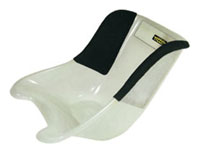Race Tech: How to Choose the Best Kart Seat for You
By Michael Marmurowicz
When choosing a new kart seat, it's often tempting to pick a seat that is too big. Most people will sit in a seat and decide which one to purchase based on comfort and ease of entry and exit. Judging seat fit in this fashion may not only impair the ability of your kart to handle, it can seriously jeopardize the driver's safety.
In a new seat, it's wise to choose a tight fit, as this offers the best protection for the ribs and other parts of the body. It may sound funny that a tight fit will do your ribs less harm, but when you have a seat that is too loose, the chances of injury are much higher. During an accident, if your torso travels some distance before making firm contact with the side of the seat, the resulting impact will be greater than if your body is hard against the side of the seat to begin with. This is the same reason people not wearing a seat belt in a car crash will suffer far greater injury than if properly restrained by a seat belt. Another important aspect to consider is that a tighter fitting seat will transmit all that the kart is doing more effectively to your body. This input is crucial to a driver who wants to stay at the absolute limit of his chassis' potential. If the seat is too large this input is diminished and the driver may lose concentration due to the distraction caused by sliding around on the seat. Think about it. How are you going to keep the kart on the track if you can't keep yourself in the seat?
The stiffness of the seat will affect how your kart handles. The straight axle dilemma is that both rear wheels can't go around a corner at the same speed. This means that to be fast, you must transfer as much weight as possible off the inside rear tire in a corner. Not having this balance right can prove disastrous to quick lap times due to unwanted tire scrub and all around poor handling. Too soft of a seat acts like a sway bar on full soft settings. It will allow the kart frame to flex straight through the seat, never lifting the inside rear tire. A basic rule of thumb for seat stiffness is this: Light driver, hard seat and heavy driver, soft seat. This rule of thumb is not chiseled in stone. There are going to be circumstances that contradict this including: chassis type, driver height, and tire compounds to name a few. The rule of thumb is based on the principle that a lighter driver such as a child will need more help in creating chassis flex than a 6' 2" adult weighing 250 lbs. The covering option is a matter of personal preference. If your seat isn't absolutely tight on your body, you will slide a bit more on a bare seat versus a fully covered version. A 1/4 padded seat has padding just on the sides. This offers a good compromise which is why it is a popular choice.
Finding a seat that fits
The best way to determine your seat size is by using your waist size and weight. The chart below will help you to find a seat that suits your size. Measurements should be made while you're wearing the safety equipment that you intend to race with, including a rib protector if appropriate. Children can be difficult to size properly. However, most average size children 5 to 8 years old will fit the Cadet size seat. The average 9 to 12 year old will fit the X-Small seat. If in doubt, measure your child and contact us, we'll be glad to help you. Also be advised that the sizes shown relate to uncovered seats. You will lose approximately a quarter inch of width on a fully covered seat.
| Seat Size | Weight (pounds) | Waist (inches) |
|---|---|---|
| Cadet | Child | Child |
| X-Small | Youth | Youth |
| Small | 110-132 | 28-30 |
| Med/Small | 133-155 | 31-32 |
| Med/Large | 156-170 | 33-34 |
| Large | 171-190 | 35-37 |
| X Large | 191-215 | 38-39 |
| XX Large | 216 + | 40 + |
One last word of advice on kart seats is to treat them as a disposable item on your kart. Tires get old and worn out, and so do seats. At a minimum, seats should be inspected regularly and replaced every season. If you are one of the thousands of drivers requiring weight to be added to meet your class minimum, you may have to replace your seat a few times each year. Most of the time, ballast weight is bolted directly to the seat. This can cause stress cracks to develop, reducing the rigidity of the seat. In due time this not only creates an unsafe situation but can substantially reduce the seat's ability to help you transfer weight. If in doubt, change it. It may be the cheapest way to reduce your lap times.


